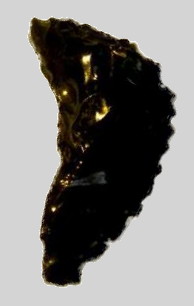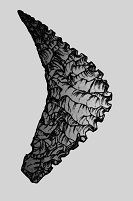Other Websites with Detailed Information:
Name Details:
Named By: Earnest N. Johnson
Named For: Type Site
Date Identified: 1940
Type Site: Stockton Mound, San Joaquin County, California (Philip M. Jones, 1923)
Stockton Curve
Cluster: Stockton Cluster
Commonly Utilized Material:
All examples are made from obsidian
Date:
Cultural Period:
1,300 -500 B.P.
Developmental -
Late Prehistoric
Vandal Minimum to
Little Ice Age
Glacial Period:
Culture:
Outline is Representative of Size and Shape:
Description of Physical Characteristics and Flaking Pattern:
This is a small to medium asymmetrical blade with a flattened to elliptical cross section. The blade is
typically crescent shaped and serrated. The serrations are usually finely made, are square, and are on the outer curved blade. However, some examples have the same deep serrations on both the outer and inner curved blade. Not all examples have a hafting region. Examples without a hafting region have a point on both ends of the blade. Examples with a hafting region generally has parallel notches that enter the blade
forming shoulders that range from horizontal to having an upward angle. The stem is expanding with a straight to convex base. This blade has a random flaking pattern.
Size Measurements: Total Length - 37 to
70 mm, Max Width - 18 to 24 mm, Thickness - 4 to 6 mm
Distribution:
Distribution Comments:
This point is primarily found in the Sacramento Delta region and into the San Francisco Bay area. These points may be found through out central California and into the northern
coastal ranges.

Related / Associated Points:
Additional Comments:
The age of the Stockton Curve may be in question. They are rarely found in at sites with other Stockton type points. The date is based primarily on the technical aspect of the Stockton Curve. The
Stockton Curve may be a newer blade than other types within this cluster. This is based on Stockton Curves that have been found in association with glass beads which places the Stockton Cluster into
historical temporal placement. (Justice, 2002). Schenck and Dawson (1929) discuss many Stockton Curve shaped artifacts that were associated with a "burnt dress" which also places this within historical context.
Point Validity: Valid Type
Johnson was an anthropologist who studied the archaeology of the Great Basin and
California. This type was named in his publication on the Stockton Mound in California. This has many professional references. This is considered a valid type.
.
Age Details:
References: (See Reference Page, Entry Number):
16, 23, 30
Stockton Corner Notch Projectile Point, Stockton Corner Notch Arrowhead


.jpg)